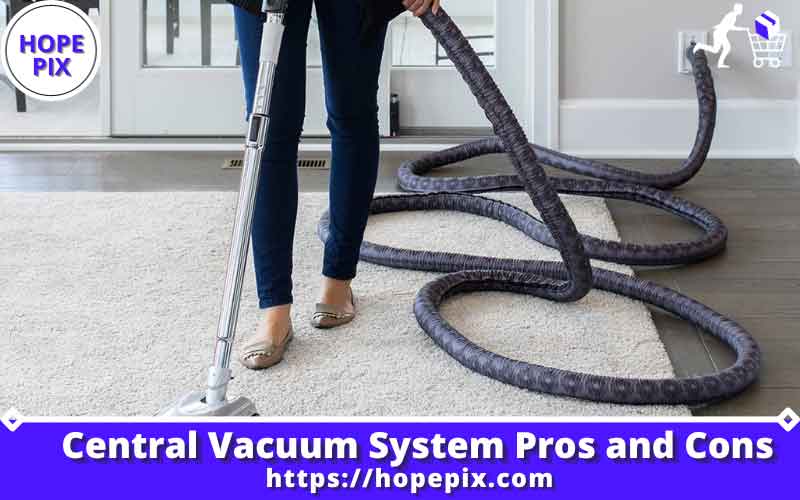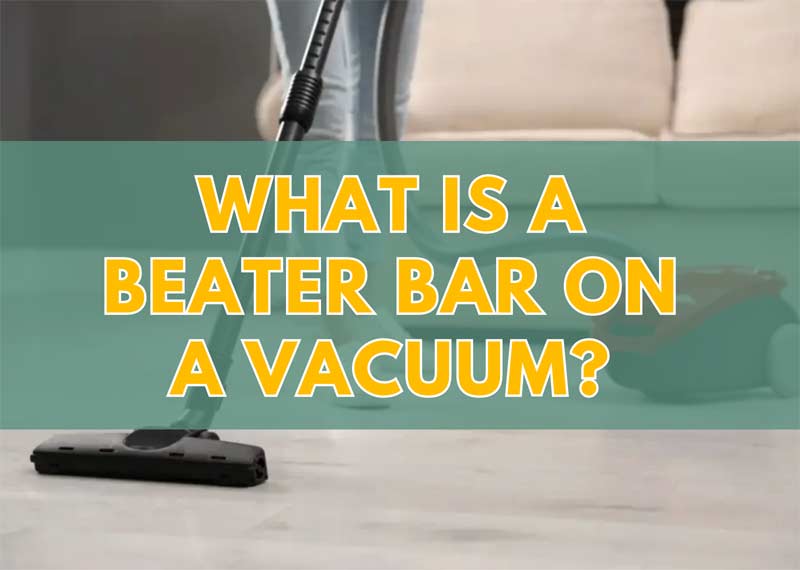A central vacuum system offers convenience and deep cleaning benefits, but installation costs and maintenance needs are important factors to consider. Central vacuum systems are gaining popularity due to their ability to provide deep cleaning with minimal effort. The system utilizes a motorized power unit and specialized cleaning accessories, allowing homeowners to clean their entire home with ease. They eliminate the need for heavy equipment and reduce the risk of dust and allergens in the air. However, the installation costs can be significant, and the maintenance needs of the system require regular attention. Homeowners should carefully weigh the convenience and benefits against the potential drawbacks before deciding if a central vacuum system is right for them. In this article we will discuss about central vacuum system pros and cons and other information.
Central Vacuum System Pros and Cons

Have you ever experienced the hassle of lugging a heavy vacuum cleaner around your house, going up and down the stairs and plugging and unplugging the cord from room to room? If so, you’re not the only one. Luckily, all of these headaches can be solved with a central vacuum system.
Cleaning Efficiency
One of the main advantages of a central vacuum system is the increased cleaning efficiency it brings. The powerful motor of the central vacuum system makes it more effective at cleaning carpets, upholstery, and hard floors than regular vacuum cleaners.
The system’s long hose, which can be up to 50 feet, allows you to easily reach every nook and cranny of your home. Plus, you don’t have to worry about the vacuum’s bag or container filling up quickly, requiring constant emptying.
- The central vacuum system has a more powerful motor, which results in better cleaning.
- Its long hose allows you to reach every corner of your home with ease.
- You don’t have to worry about emptying out the dirt container frequently.
Less Noise
If you don’t want to disturb your family, pets, or neighbors during vacuuming, a central vacuum system could be the answer. This type of vacuum is much quieter compared to standard vacuums. Its motor and dirt container are installed in the central location, usually either in the garage or the basement, far away from the main living areas of the house. As a result, the noise emitted from the system is dramatically reduced.
- A central vacuum system is much quieter than a regular vacuum cleaner.
- The motor and dirt container are installed in a central location, away from the living areas of the house.
Improved Air Quality
While vacuuming, a central vacuum system not only sucks up dirt, dust, and debris, but it also captures microscopic particles like allergens, bacteria, and pet dander. These particles are then trapped inside the dirt container, where they are less likely to be recirculated into the air you breathe.
As a result, a central vacuum system can significantly improve the air quality of your home, making it a great choice for people with allergies or respiratory problems.
- A central vacuum system captures microscopic particles, including allergens, bacteria, and pet dander.
- The trapped particles are less likely to be recirculated into the air you breathe.
- It can significantly improve the air quality of your home, which makes it an excellent choice for people with allergies or respiratory problems.
With a central vacuum system, cleaning your house has never been easier, faster, and more convenient. Not only does it increase cleaning efficiency and improve air quality, but it also reduces noise. Make sure to research and find the perfect central vacuum system for your home to see how much easier your cleaning routine can be.
Save Money In The Long Run
Reduced Maintenance Cost
One of the advantages of having a central vacuum system is the reduced maintenance cost. This type of system requires less maintenance than traditional vacuum cleaners. Here are some reasons why:
- The central vacuum system doesn’t have a motor or a filter that needs to be replaced as frequently as traditional vacuum cleaners.
- Because the motor is located outside of the living area, the system doesn’t produce any harmful allergens or dust, which can reduce the need for cleaning.
- The system has a longer lifespan and requires less maintenance due to the fact that it has fewer parts that can break down over time.
Increased Property Value
Having a central vacuum system can also increase your property value. Here are a few reasons why:
- A central vacuum system is seen as a luxury item, and having one can add value to your home.
- It makes cleaning much easier and faster, which can be a selling point for buyers who are looking for a convenient and efficient way to keep their home clean.
- A central vacuum system can also be a selling point for those who suffer from allergies or asthma, as it can improve the air quality in the home.
A central vacuum system can save you money in the long run and increase your property value. Its reduced maintenance cost, longer lifespan and better air quality make it a practical and valuable investment.
A Green And Eco-Friendly Cleaning Alternative
Central vacuum systems provide a green and eco-friendly alternative to traditional vacuum cleaners. Here are some of the main benefits of using a central vacuum system:
Reduce Household Waste
- Vacuum bags need to be replaced regularly, producing waste.
- Central vacuum systems do not require disposable bags, therefore reducing household waste.
- The dirt and debris are stored in a large container, making it easy to dispose of.
Harness The Power Of Nature
- Central vacuum systems do not emit harmful pollutants or allergens because they use natural suction power.
- The system uses heavy-duty motors that run on electricity, so it is essential to choose an energy-efficient system.
- These systems are also designed to minimize noise pollution, making them more environmentally friendly than traditional vacuum cleaners.
Central vacuum systems are a fantastic eco-friendly cleaning solution that provides numerous benefits over traditional vacuum cleaners. By installing a central vacuum system, you’re not only doing your part for the environment but also improving the air quality in your home, reducing your energy bills, and making your cleaning tasks a lot more manageable.
High Upfront Cost
Central Vacuum System Pros And Cons
Central vacuum systems are becoming more popular in modern homes as people want to save time and energy. These systems are an investment, and it’s important to weigh the pros and cons before making a decision. We will discuss the high upfront cost associated with central vacuum systems.
Cost Of Installation
When considering a central vacuum system, one of the most significant factors to consider is the initial investment. Here are some key points to be aware of concerning the cost of installation:
- The cost of installation varies based on several factors, including the size of the home, design of the layout, and complexity of the system.
- On average, installing a central vacuum system in an existing home costs between $1,000 and $3,000, while a new home’s installation can cost up to $4,000.
- Keep in mind that this is a one-time expense for the life of the system, and it adds value to your home.
Required Maintenance
Like any appliance or device, central vacuum systems require some maintenance to keep them running smoothly. Here are the key points to consider regarding required maintenance:
- Regular maintenance of the system will help ensure efficient operation and maximise the lifespan of the system.
- Filters and bags need to be changed periodically, and it’s a good idea to have the system checked professionally every few years.
- The cost of maintenance is relatively low, with filters and bags costing about $50 per year, and a professional check-up costing around $100.
Central vacuum systems come with a high upfront cost, but they are an excellent investment in your home’s value, convenience, and cleanliness. With proper maintenance, they will last for many years and save you time and effort.
Requires Increased Storage Space
Central Vacuum System Pros And Cons: Requires Increased Storage Space
When opting for a central vacuum system, one thing that homeowners need to consider is that it requires increased storage space. Unlike traditional vacuum cleaners, central vacuum systems consist of hoses and the vacuum unit, both of which need to be stored properly. Let’s take a closer look at these storage requirements.
Space To Store Hoses
Central vacuum systems use long hoses to connect cleaning accessories to the system. The hoses can range in length from 20 to 50 feet, depending on the size of the home. Homeowners must have a dedicated space to store the hoses safely.
- One option is to install hose hangers or hooks on the wall in the storage space. This positioning keeps the hoses off of the floor.
- Another option would be to build custom cabinetry in your storage space to keep the hoses out of sight when not in use.
Place To Mount The Vacuum Unit
Homeowners should opt for the central vacuum unit installation that offers the most convenience and usability when considering storage requirements. The unit typically has a 50-gallon storage capacity, which can make it bulky and challenging to store. Ideally, homeowners need to have the following:
- Sufficient floor space designated for the central vacuum unit.
- Wall-mounted installation of the central vacuum unit, which will free up floor space and allow cleaning accessories to be hung within reach.
- Close proximity to power outlets for the system to function correctly and minimise tripping hazards.
While central vacuum systems offer many advantages over traditional vacuum cleaners, homeowners will need to consider the storage requirements of the system before making a purchase. The essential take away is that you will save space over time, but in the short term, the system will take up more storage space than a traditional vacuum cleaner.
Limited Mobility
Central Vacuum System Pros And Cons
Central vacuum systems are a boon, especially when it comes to keeping the house clean. However, just like any other appliance, they also have drawbacks. We will be discussing the pros and cons of the central vacuum system.
One of the most significant limitations of a central vacuum system is that it may prevent them from cleaning hard-to-reach areas. Here are some key points to remember:
- Distance from vacuum canister: The distance from the vacuum canister makes it difficult to clean areas far from the main unit. The hose must be huge enough to reach all areas in the home.
- Hose management: Another problem with central vacuum systems is that hoses can be heavy and difficult to manage. Homeowners must take additional measures to manage hoses and not trip over them.
While central vacuum systems are undoubtedly a fantastic investment in your home, they are not without drawbacks. One must thoroughly consider the limitations before investing in one.
Compare Central Vacuum Systems To Traditional Vacuum Systems
Central Vacuum System Pros And Cons
Central vacuum systems have come a long way since their invention in the late 19th century. These systems, which are installed in a central location and use powerful suction to clean floors and even walls, have become increasingly popular over the years.
However, traditional vacuum systems still have their advantages. We’ll compare central vacuum systems to traditional vacuum systems, including the bagged vacuum, bagless vacuum, and stick vacuum.
Bagged Vacuum
A bagged vacuum is a traditional vacuum system that uses a disposable bag to collect dirt and debris. Here’s what you need to know about bagged vacuums:
- Bagged vacuums are less messy than bagless vacuums, as you have limited contact with dirt and debris.
- Bagged vacuums are more hygienic, as the bags can be easily removed and disposed of without releasing any trapped allergens or dust particles back into the air.
- However, bagged vacuum cleaners can be more expensive over time, as replacement bags need to be purchased regularly and can be costly.
- The suction power of bagged vacuum cleaners can decrease as the bag fills up, and the bags need to be changed regularly to maintain optimum performance.
Bagless Vacuum
Bagless vacuums, on the other hand, use a collection bin or cup to trap dirt and debris. Here are some pros and cons of bagless vacuums:
- Bagless vacuums are less expensive over time, as you do not need to purchase replacement bags regularly.
- Bagless vacuums can be more environmentally friendly, as they create less waste.
- However, emptying the collection bin can be messy, and dust and allergens can be released back into the air if not emptied correctly.
- Bagless vacuums can require a lot of maintenance to keep them functioning properly and may not have the same suction power as bagged vacuums.
Stick Vacuum
Stick vacuums are lightweight, cordless vacuum cleaners that can be used to clean floors quickly and easily. Here are some of the pros and cons of stick vacuums:
- Stick vacuums are lightweight, making them easy to maneuver and store.
- Stick vacuums are cordless, so you can move around freely without worrying about a cord getting in the way.
- However, stick vacuums are not as powerful as traditional vacuum cleaners and may not be suitable for heavy-duty cleaning.
- Stick vacuums have a limited battery life and may require frequent charging.
Central vacuum systems come with many benefits, such as convenience and increased suction power, compared to traditional vacuum systems. However, traditional systems still have their advantages, such as cost-effectiveness and ease of maintenance. Ultimately, it’s up to you to decide which system is best for your home.
Conclusion
To sum up, a central vacuum system comes with both advantages and drawbacks. It is a convenient and efficient approach to keep your home clean without using handheld vacuums. It enhances indoor air quality by minimizing allergens and dust, has low noise levels and is durable. Central vacuum systems are energy efficient and add value to your home. However, they require a high initial investment, need professional installation and maintenance, and can be difficult to repair. The length of the hose is limited, and the system requires more space. Moreover, the vacuum system is not portable and cannot be carried to other locations. To make the correct decision, it is important to consider your lifestyle, size of the house, budget, and priorities. If you prioritize long-term convenience, air quality, and maintenance and have sufficient resources, a central vacuum system can be a great investment.
Frequently Asked Questions On Central Vacuum System Pros And Cons
A central vacuum system has a main unit that is installed in a utility room or garage and is connected to a network of pipes throughout the house. When you connect the hose to a wall inlet, it triggers the system to turn on, and the dirt and debris are transported through the pipes and sucked into the main unit.
A central vacuum system offers numerous benefits over a traditional vacuum cleaner. It provides better cleaning power, reduces exposure to dirt and dust, increases indoor air quality, and is low maintenance and easy to use. Additionally, it can add value to your home and reduce noise pollution.
A central vacuum system can improve indoor air quality by collecting dirt, dust, and debris in its main unit, which is often located in the garage or basement. This means that household dirt and allergens are removed from living areas and does not recirculate into the air you breathe like a traditional vacuum cleaner.
The cost of a central vacuum system varies based on factors such as size, power, brand, and complexity. However, the average cost of a system installation is between $1,000 and $3,000, including installation fees. It may seem high compared to traditional vacuum cleaners, but it is a cost-effective long-term solution.
Installing a central vacuum system involves cutting into walls and running piping, so it is best to hire a professional installer to ensure a safe, accurate, and proper installation. The installer will also make recommendations based on the size of your home, your specific needs, and budget so that you can get the best possible results.

Hi there! I’m Tareq, the vacuum aficionado behind the reviews on this site. With a passion for spotless spaces and a knack for dissecting vacuum features, I’m here to simplify your hunt for the perfect cleaning companion. Let’s make cleaning a breeze together!

